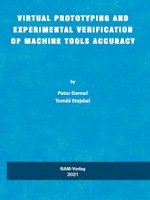|
 |
PREFACE
We have prepared the presented scientific monograph in order to acquaint the general
scientific and professional public with some research results with the results of numerical
and experimental research of the properties of machine tool construction in terms of their
impact on their working accuracy. Identifying the influences of the machining process
itself, as well as the influences of the design properties of the machine tool, will make it
possible to predict and subsequently optimize its design in terms of its achieved working
accuracy. The practical importance of virtual machining and experimental research in this
area is primarily in reducing financial costs and speeding up machine design without the
need to produce a physical prototype. Using simulation models, it is possible to repeatedly
analyze the weak points of the machine design, determine the effects of individual
components of the machine on its properties and optimize them, but also take into account
ergonomic and other requirements.
The publication draws on the results of the authors‘ own research activities within the
grant project KEGA no. 025TUKE-4/2019: Integrated training laboratory of virtual
prototyping and experimental verification of machine tools accuracy and from previous
grant research projects, partial results of which have been published in works listed in the
bibliography. Developed and verified methodologies of virtual machining, mathematical
simulations and experiments are developed by the scientific field of Production Machines
and Equipment and can be used in industrial practice in existing, respectively potential
machine tool manufacturers.
The authors thank the reviewers, namely Prof. h. c. Prof. Ing. Karol Velíšek, CSc.
from the Faculty of Materials Science and Technology in Trnava, Prof. Ing. Jozef Pilc,
CSc. from the Faculty of Mechanical Engineering of the University of Žilina and Prof. Ing.
Slavko Pavlenko, CSc. from the Faculty of Production Technologies of the Technical
University in Košice based in Prešov for careful reading of the manuscript of the
monograph and their valuable comments and advice, which contributed to the improvement
of the publication and will be an inspiration for us in the future.
At this point, we would also like to thank our families for their quiet support and the
immense tolerance they have endowed us with our work on the publication.
Košice, October 31, 2021
Authors
